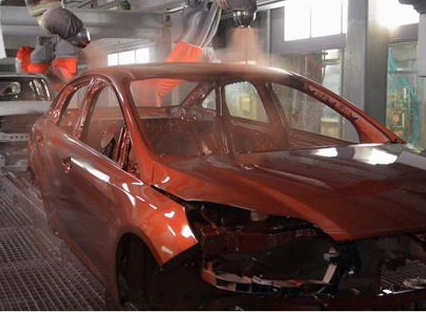Qingyuan Automobile Repair Paint Company tells you the steps for painting
Automotive Painting Process
(1) Rust prevention and internal painting of the vehicle body: Depending on the condition of the vehicle body, it will be completed by a sheet metal worker.
(2) Polishing and Decorating Beveled Edges: Use P60~180 # sandpaper to polish the parts on the vehicle body that have been repaired with sheet metal and require atomic ash.
(3) Dust removal and cleaning: Use a pressure gun and silicon remover to remove fine dust and stains from the vehicle body.

(4) Sticking: Apply masking paper using reverse sticking techniques.
(5) Primer coating: Mix 4:1 red primer and apply 1-2 layers of polishing to expose the metal, then dry.
(6) Add atomic ash: Mix multifunctional atomic ash to add to the depression position on the car body, and place it in a 20 degree Celsius environment for 30 minutes.
(7) Polishing atomic gray: Use P60~240 # sandpaper to polish, and check the flatness, pinholes, and imprints using a touch or polishing indicator layer.
(8) Extra young atomic gray: selected when needed, supplemented with pinholes, sandpaper marks, etc.
(9) Polishing: Use P280 # sandpaper to completely polish the old paint that needs to be sprayed with medium paint on the vehicle body.
(10) Dust removal and cleaning: Use a pressure gun and silicon remover to remove dust and stains from the vehicle body.
(11) Cover: Apply masking paper.
(12) Spraying intermediate paint: Mix 2-3 layers of multi-functional intermediate paint, with intervals of 5-10 minutes between each layer, then dry at 60 degrees Celsius for 30 minutes, and then spray a polishing indicator layer.
(13) Polishing intermediate paint: Use P320~400 # sandpaper to polish the dry intermediate paint.
(14) View: Check the polishing effect and can be used for micro filling.
(15) Dust removal and cleaning: Remove dust and stains from the vehicle body.
(16) Cover: Cover and cover the vehicle body.
(17) Dust removal and cleaning: First, use a pressure gun to blow out dust spots on the vehicle body, use a silicon remover to remove stains on the vehicle body, use a pressure gun to blow out dust from the gaps in the vehicle body, and then use a dust cloth to remove any fine dust on the vehicle body.
(18) Topcoat spraying: Spray 2-3 layers of plain paint, with intervals of 5-10 minutes between each layer. Increase the curing agent and diluent at the cooperating temperature.
(19) Spraying base paint: Spray 2-3 layers of plain paint, silver powder paint or pearl paint, with intervals of 5-10 minutes between each layer.
(20) Varnish spraying: Mix and spray two layers of varnish, with an interval of 5-10 minutes between each layer. Increase the curing agent and diluent at the cooperating temperature.
(21) Drying: Let stand for 5-10 minutes, dry at 60 degrees Celsius for 30 minutes. Dry curing requires judgment. If you feel sticky with your fingers, it means the appearance is dry. If you touch lightly without leaving finger marks, it means semi hard and dry. If you press hard without leaving finger marks, it means completely dry.
(22) Waxing and polishing.
(23) Cover the car. The purpose of covering the car is to prevent the spray from spraying to the place where it should not be sprayed
Article source: Qingyuan Automotive Repair Paint http://www.jinliangxincai.com/
-
08-25
Common problems with automotive repair paint
Why are the orange lines on the surface of the varnish so heavy after each spray? Why on earth? How can we prevent a decrease?Answer: The thinness of the varnish, the amount of paint produced by the s
-
06-05
The car repair paint manufacturer told you about the problem with water-based coatings
1. How long does it take for a skilled paint coating technician to master the operation of water paint?Generally, practice and understanding with less than half a sound can be mastered, and proficienc
-
05-31
Qingyuan Automobile Repair Paint Company tells you the steps for painting
Automotive Painting Process(1) Rust prevention and internal painting of the vehicle body: Depending on the condition of the vehicle body, it will be completed by a sheet metal worker.(2) Polishing and
-
05-12
Why does car repair paint lack luster?
If there is a lack of gloss on the surface of the originally flat and smooth car paint surface, especially during the process of car paint care, it can be observed under a microscope that the surface
